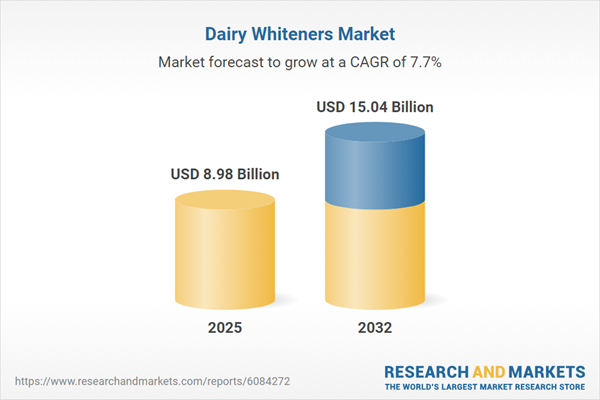Speak directly to the analyst to clarify any post sales queries you may have.
The dairy whiteners market continues to evolve as a crucial component in beverage and food applications, driven by shifting consumer expectations, supply chain dynamics, and product innovation. Senior decision-makers seeking clarity on industry direction, regulatory shifts, and strategic opportunities will find actionable insights in this comprehensive analysis.
Market Snapshot: Dairy Whiteners Industry Performance and Growth Trajectory
The Dairy Whiteners Market grew from USD 8.33 billion in 2024 to USD 8.98 billion in 2025. It is expected to continue growing at a CAGR of 7.66%, reaching USD 15.04 billion by 2032. This robust expansion reflects increased demand in both foodservice and retail channels, propelled by greater consumer focus on convenience, shelf stability, and quality consistency.
Scope & Segmentation in the Dairy Whiteners Market
This report delivers an in-depth analysis across crucial market segments and regional dimensions, enabling industry leaders to refine strategic approaches:
- Product Types: Calcium carbonate for neutral color and cost efficiency; sodium caseinate for protein enrichment and texture; starch-based whiteners for clean-label credentials; whey powder for health-oriented uses.
- Form Factors: Options include liquid whiteners suited for quick dissolution, and powder forms valued for stability and versatility.
- Distribution Channels: Diverse routes such as direct sales, grocery stores, online retail, and supermarkets/hypermarkets to maximize reach and customer engagement.
- End User Groups: Serving the HORECA segment, household consumers, and industrial processors—all with distinct requirements for performance and scalability.
- Regional Coverage: Analysis spans the Americas (including North America and Latin America), Europe, Middle East & Africa, and Asia-Pacific, each with distinct drivers and consumption preferences.
- Technology Drivers: Advances in membrane filtration, enzymatic processing, and digital traceability solutions are shaping innovation and supporting compliance.
- Key Companies: Assessed firms include Nestlé S.A., Société Lactalis, Fonterra Co-operative Group Limited, Danone S.A., Koninklijke FrieslandCampina N.V., Kerry Group plc, The Kraft Heinz Company, Arla Foods amba, Saputo Inc., and Olam International Limited.
Key Takeaways for Senior Decision-Makers
- Demand for clean-label and health-focused dairy whiteners is accelerating, prompting manufacturers to adopt natural protein sources and reduce artificial additives.
- Technology adoption—such as advanced filtration and ingredient modification—is improving ingredient solubility, flavor, and shelf stability, attracting both mass-market and artisanal brands.
- Sustainability and supply chain transparency are rising priorities, encouraging collaborative procurement, eco-friendly packaging, and waste-reduction initiatives.
- Regulatory compliance is shaping product development, with enhanced food safety standards, robust quality assurance, and labelling reforms influencing ingredient sourcing.
- Segmentation by product type, form, and channel enables targeted marketing strategies and optimizes value delivery across distinct end-user segments.
- Regional strategies must reflect differences in consumer preferences, regulatory frameworks, and infrastructure—from protein-fortified products in North America to traditional starch-based solutions in South Asia.
Tariff Impact: Strategic Implications of 2025 U.S. Duties
The 2025 U.S. tariffs have introduced cost pressures across the dairy whiteners supply chain, affecting procurement and production decisions. Companies are reassessing sourcing strategies, exploring regional trade partnerships, and implementing inventory adjustments to manage price volatility. Maintaining resilience in the face of these shifts requires tactical supplier engagement and investment in local ingredient development alongside process efficiencies.
Methodology & Data Sources
This report employs a combination of qualitative and quantitative methodologies. Secondary research involved industry publications and regulatory documents, while primary research engaged stakeholders through interviews and surveys, ensuring nuanced market perspectives. Data triangulation, outlier detection, and sensitivity analysis underpin the reliability and objectivity of the findings.
Why This Report Matters for Dairy Whiteners Market Strategy
- Enables informed decision-making through granular market segmentation, technology analysis, and regional insight relevant to the dairy whiteners sector.
- Identifies how shifting consumer trends, competitor initiatives, and regulatory requirements will impact supply chain, product portfolio, and go-to-market strategies.
- Equips leaders with the knowledge to optimize operations, enhance sustainability, and unlock targeted growth opportunities in a complex industry landscape.
Conclusion
Senior leaders equipped with this analysis will navigate a rapidly evolving dairy whiteners market by leveraging segmentation, supply chain agility, and sustainability. A strategic, data-driven approach ensures competitive positioning as innovation and market complexity intensify.
Table of Contents
3. Executive Summary
4. Market Overview
7. Cumulative Impact of Artificial Intelligence 2025
Companies Mentioned
The companies profiled in this Dairy Whiteners market report include:- Nestlé S.A.
- Société Lactalis
- Fonterra Co-operative Group Limited
- Danone S.A.
- Koninklijke FrieslandCampina N.V.
- Kerry Group plc
- The Kraft Heinz Company
- Arla Foods amba
- Saputo Inc.
- Olam International Limited
Table Information
| Report Attribute | Details |
|---|---|
| No. of Pages | 193 |
| Published | October 2025 |
| Forecast Period | 2025 - 2032 |
| Estimated Market Value ( USD | $ 8.98 Billion |
| Forecasted Market Value ( USD | $ 15.04 Billion |
| Compound Annual Growth Rate | 7.6% |
| Regions Covered | Global |
| No. of Companies Mentioned | 11 |









